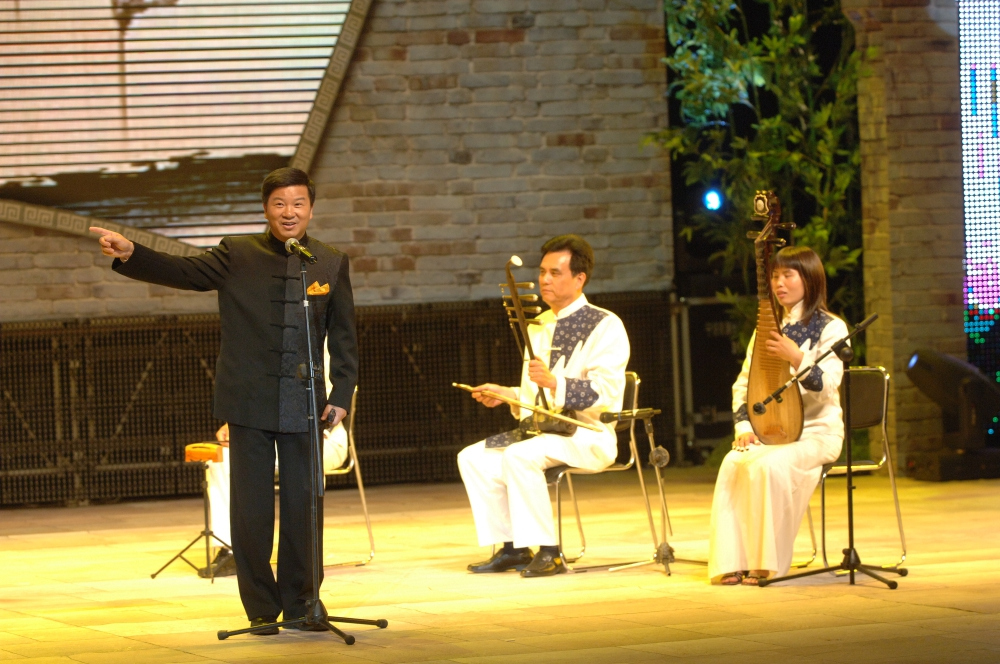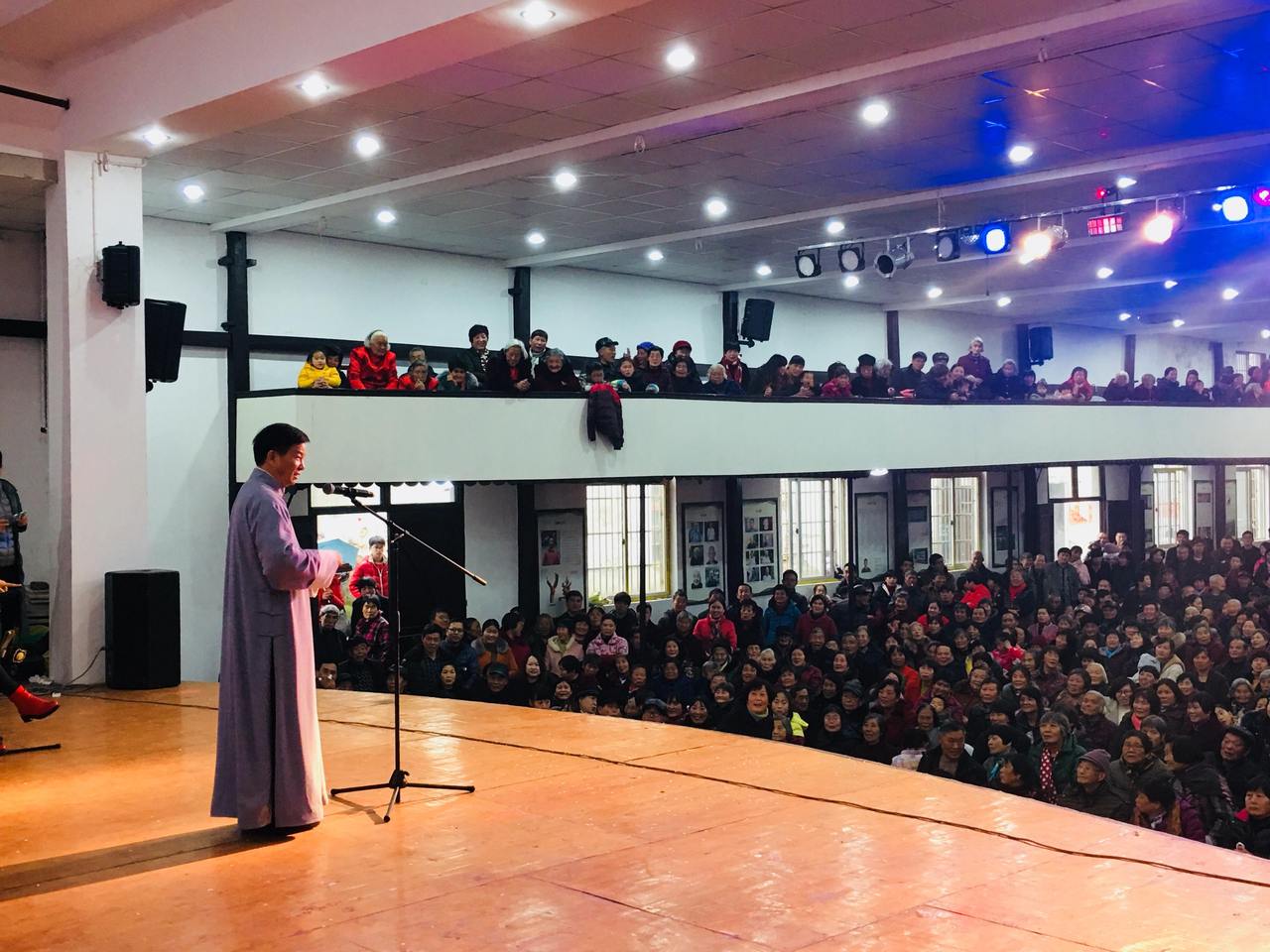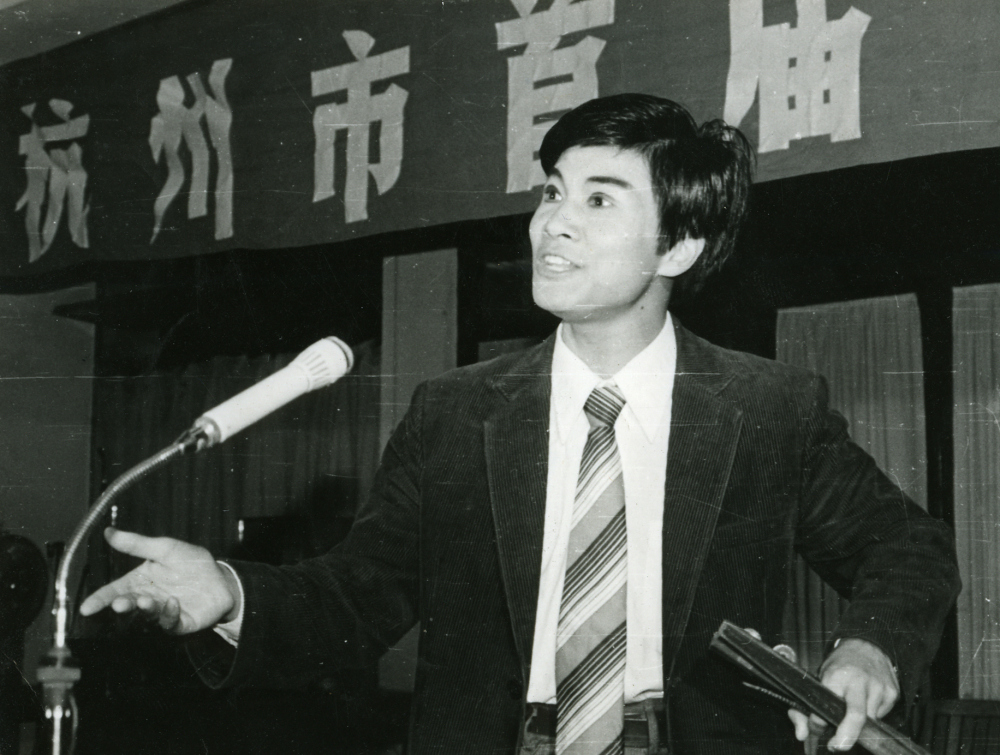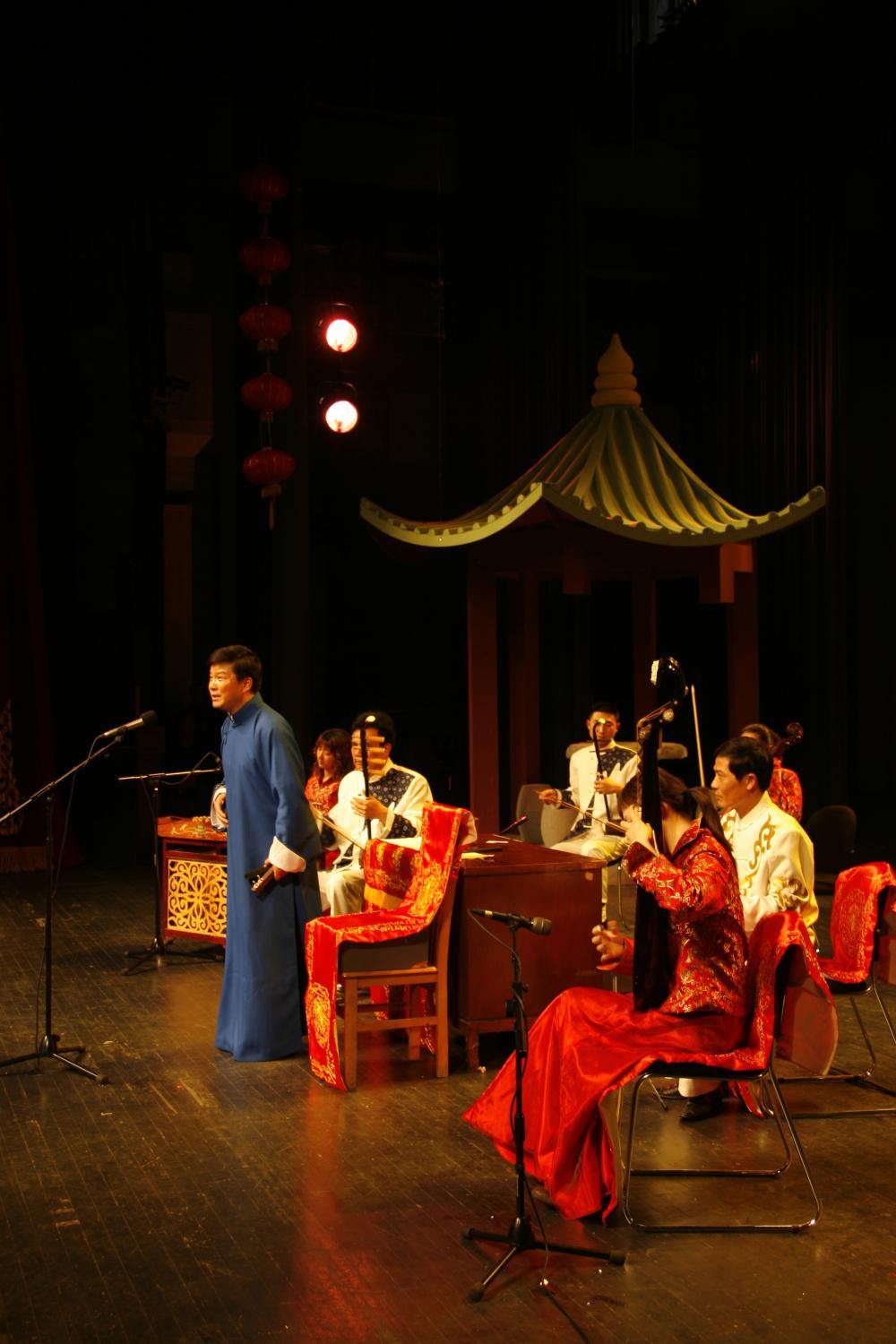在一个微信群,看到一段曲艺视频,唱者着布衣长衫,外景地是我的家乡绍兴安昌古镇,演员吟唱的是安昌的风土人情。从拍摄的画面看,有些年头了,但唱腔十分熟悉,只是我无法确认这是绍剧、越剧还是莲花落。于是,请教同为绍兴籍的老乡吉祥。吉祥对曲艺有研究,创作过不少曲艺作品。吉祥看过视频,肯定地说,是纯正的绍兴莲花落,表演者是余姚姚剧团演员寿建立,而演唱配音则是杭州民间艺人陈宝海。这段莲花落是《大年三十》里的经典唱段,描述的是安昌古镇的腊月场景。吉祥进一步说,这是二十年前的视频了。为了证明他的记忆无误,他特意发了一张与陈宝海的合影。从照片上看,无论是吉祥还是陈宝海,都显得意气风发。
一
看到这段莲花落视频,倒让我想起一些往事。在我小时候,很多与古镇文化生活有关的声音中,莲花落堪称主角。尽管我早先对莲花落的认知,有一定局限。
从小耳濡目染,总觉得莲花落是绍兴地区特有的曲艺。记得有个叫胡兆海的莲花落演员,唱过《回娘家》,给我留下深刻印象。我看过胡兆海的现场演出,当时场面之火爆,现今难以想象。
“尺板的笃琴弦起,我一人上场唱台戏……”这是胡兆海上场时的固有唱段。这唱段一起,我们就知道是胡兆海要出场了。他的拿手好戏是《回娘家》。这出戏,几乎可以肯定是振兴绍兴莲花落的分水岭。而胡兆海也因此在曲艺界有了自己的地位,这部作品曾获得全国曲艺汇演南方片创作和表演一等奖。据说,胡兆海在参加国家文化部组织的全国曲艺优秀节目赴西南、西北十三个省市巡演时,也受到热捧。即使在天山南北的新疆,草色无边的青海,胡兆海的绍兴莲花落《回娘家》也无一例外都是最受欢迎的曲目之一。有知情者称,通常,他在台上唱,台下密密麻麻放满一排录音机。演出结束后,观众就拎着录音机,一边听着《回娘家》一边走回家。这种情形,用现在的眼光来看,简直就是奇迹。但确实,在文化相对贫乏的年代,包括莲花落在内的戏曲一度兴盛不衰。

通常,在追溯莲花落的历史时,研究者们普遍认为,莲花落早先流行于北方的京、津、冀等地,一作莲花乐,源于唐、五代时的“散花乐”,宋代始流行于民间。清乾隆以后,出现了职业艺人,同时满族八旗子弟中也有不少爱好者,遂与民间流行的另一艺术形式“十不闲”合流,成为民间花会形式之一“天平会”,曲种名为“十不闲莲花落”,又称“十不闲”或“莲花落”。内容多为写景抒情和演述民间故事的俗曲。演出时,先由全体人员敲击名叫十不闲的数种打击乐器,做舞蹈动作,唱“四喜”“八掌”“架子曲”等曲调,此为序曲,然后演唱莲花落节目。
有一个重要的历史事件,能够说明莲花落的不同凡响。光绪二十六年(1900年)八国联军入侵北京时期的西什库教堂受围事件,被后人编写了一个莲花落唱段《房国梁观阵》。这个唱段的具体内容我没有看到,但据此可以证明,作为一种地方戏曲,莲花落的起源颇有历史。
莲花落在文字里最有说服力的记载,与文学名著《金瓶梅》有关。清朝的丁耀亢在他的《续金瓶梅》第十六回“沈乞儿故园归梦 翟员外少女迷魂”中有一段关于莲花落的描述:
到了长街,一时肉痒难熬,只得把金砖高举,打个莲花落为乐,看官听着他道……
二
必须承认,戏曲艺术在年轻群体中的地位正在逐渐式微。类似莲花落,也被列入国家级非物质文化遗产名录,可见其传播与传承的难度。但是,也有一些执着的艺术工作者,把莲花落当作生命的一部分,孜孜以求。在江南,除了上述胡兆海,现在活跃在曲艺舞台上并且以莲花落赢得广泛认可的,非翁仁康莫属。
身兼中国曲协副主席的翁仁康也可以被认为是莲花落最优秀的传人。翁仁康的诞生地是萧山瓜沥,与我的老家安昌毗邻,同属一个语系,虽然浙江地区隔县不同音,但相距不过五公里的瓜沥与安昌,在语言发音上几乎没有差别。所以,翁仁康唱绍兴莲花落,有地域方面的优势。

翁仁康在舞台上受欢迎的程度,一度神奇到让人无法想象。打个比方,爱听绍兴莲花落的观众,几乎没有不认识翁仁康的,只要翁仁康在舞台上一亮相,连四五岁的小孩子也会叫一声“翁仁康,莲花落”,翁仁康差不多成了莲花落的代名词。
在翁仁康的莲花落艺术生涯中,除了胡兆海,还有一个叫倪齐全的莲花落演员也起到重要作用。当时的萧山,无法给年轻的翁仁康提供学习莲花落的条件,于是,他找来录音机当老师,跟着录音机学,对着镜子唱,天天跑广播站翻录磁带。有一次,翁仁康听说绍兴曲艺团的莲花落演员倪齐全来萧山献艺,他竟骑车赶了20多公里去观看。以后,翁仁康常常一个人踏着辆破旧的自行车到杭州、绍兴去听莲花落、评弹等,回来后,就自己摸索、跟学,直到认识了著名演员胡兆海,拜其为师。

很多艺人在舞台上的光鲜背后,总有一段苦难的日子,翁仁康也不例外。但是,令人欣慰的是,因为翁仁康的呕心沥血和倾情推动,莲花落似乎没有明显衰落的迹象。每年,他会花大量时间下乡,到农村田头去演出。他知道,莲花落最大的观众群体在基层。社区有文艺演出,他也是有邀必到。曲艺演出的最好时间段往往是节假日,尤其是春节。所以,翁仁康和他的莲花落团队通常是“曲艺节日不放假”。翁仁康说过,我是农民的儿子,报答养育我的土地,是我永远想做、要做的。
“我们的村晚”是富有浙江特色的文化活动,已经连续坚持了多年,受观众欢迎的程度出人意料。第五届“村晚”在杭州富阳区场口镇文化礼堂演出和录制时,翁仁康是这台“村晚”的主角。和所有大型文艺演出一样,“我们的村晚”从确定节目到彩排,直到最后录制,甘苦自知。我在翁仁康的微信朋友圈看到,在“村晚”的磨合过程中,翁仁康累得只有一句话:“我们的村晚”磨合中,大家都很苦,包括我……
忙完“我们的村晚”,翁仁康又出现在“新春送欢乐 文化进万家”曲艺小分队的队列中。他们深入村庄,为村民演出大家喜闻乐见的曲艺节目。翁仁康说:“曲艺节日不放假,老百姓那么喜欢我们,我们就多去唱几场吧。”
莲花落在农村基层受欢迎的程度出乎我的意料。2019年大年初二,在萧山瓜沥镇航民村的一场主题为“春暖小城”翁仁康曲艺专场晚会的演出中,可容纳上千人的剧院座无虚席,从翁仁康推送的微信画面上看,观众大多是本地村民,他们观看演出时笑得前仰后合的神态,让我也忍不住笑出声来。

20世纪60年代起,有一个村干部,带领群众,历时30余年,靠着锄头、钢钎、铁锤和双手,在绝壁上凿出一条长9400米、地跨3个村的“生命渠”,结束了贵州省遵义市播州区平正仡佬族乡草王坝长期缺水的历史,乡亲们亲切地把这条渠称为“大发渠”。而带领村民开凿这条“生命渠”的村干部,就是被誉为“当代愚公”的黄大发。
翁仁康与汪家宝联袂创作的绍兴莲花落《当代愚公黄大发》作为“第六届全国道德模范故事汇”基层巡演曲目,先后在武汉、南京等多地巡演。在南京站巡演结束后,因为次日上午有会,翁仁康当夜赶回杭州,凌晨三点半,他推送了一条微信:从南京演完开车回杭要到这个点,我不发个朋友圈你永远也不知道我有这么辛苦。八点半还有个会,希望留下的一点点时间别失眠了……晚安。应该说早安了……
除了在翁仁康的微信朋友圈点个赞,我不知道还有什么词汇和语言,可以表达我对他的敬意。翁仁康和他的曲艺界朋友们,为了莲花落能够在中华曲艺界独树一帜,生生不息,呕心沥血,堪称当代曲艺愚公。
一种曲艺,以莲为姓,花落花开,占尽天下美名。莲花落,真是取了一个绝世好名。
Popular Ballad Singing Still Blooming in Rural Areas
The other day I watched a video clip on WeChat, China’s biggest social media, showing a singer dressed in a traditional gown and singing in a local dialect of Shaoxing. I was sure the artist was in Anchang, an ancient town in Shaoxing in eastern Zhejiang where I grew up. But I was not sure whether it was a Shaoju Opera piece or Yueju Opera piece or a Lian Hua Lao (Lotus Flowers Fall) piece he was singing. All the three are local entertainment genres in Shaoxing and share similarities. I contacted a scholar who has a profound knowledge of folk entertainments in Shaoxing for information on the video clip. He said it was an authentic performance of Lotus Flowers Fall of Shaoxing. He then gave me a lengthy and detailed piece of information on the video clip: the artist was Shou Jianli, a member of the Yuyao Yaoju Opera Troupe, the voiceover was Chen Baohai, a folk artist of Hangzhou, and the aria was originally from a long show called the Eve of Spring Festival. My friend went on to say that the video had been made 20 years before. In order to convince me, he showed a photo in which were my friend and Chen Baohai.
The experience reminded me of the past. Though Lian Hua Lao was extremely popular in rural Shaoxing and surrounding areas when I grew up in Anchang, what I knew about the entertainment was highly incomplete and inaccurate. The entertainment still thrives in Shaoxing, but it originated in the north. It enjoyed popularity in Beijing, Tianjin and Hebei Province. The roots of this special folk entertainment can be traced to the Tang Dynasty (618-907). In the Qing Dynasty (1644-1911), there appeared professional performers who specialized in this ballad singing. A performance usually started with a music prelude and then performers went on to tell a story in singing. In 1900, someone wrote a Lian Hua Lao piece about the Boxers’ attack on a church in Beijing.

How the popular entertainment genre came all the way to Shaoxing in the south and how it became popular in this part of eastern Zhejiang and how it still enjoys popularity remain unknown. But it is a fact that it was very popular in Shaoxing for decades. Hu Zhaohai was the most famous artist of this genre back then. He won a top prize at a national competition and went on a road show across the country. Theatergoers were so crazy about him that they put their recorders near the stage while Hu performed. When a show was over, audience members went home carrying recorders and singing what they just heard from the show.
However, the entertainment show can’t compete against television dramas and movies. Over the past decades, its popularity has been declining so much that it has been inscribed on a list of national intangible cultural heritage. However, some artists still perform Lian Hua Lao. The best known among them is Weng Renkang, born in 1960 in Guali, only five kilometers from Anchang. Though Guali and Anchang are in two different administrative regions and though generally speaking, different dialects are spoken in different regions, the dialect spoken in Guali and the dialect spoken in Anchang sound very much like each other. This gave Weng an advantage. When Weng started learning Lotus Flowers Fall at the age of 17, the country was seeing the total outbreak of the Cultural Revolution (1966-1976), he didn’t have a teacher. He played a record again and again and performed in front of a mirror. One day he bicycled 20 kilometers to watch a Lotus Flowers Fall performance. During these days, he biked to Hangzhou and Shaoxing frequently to watch entertainment shows. Back at home, he tried to absorb what he had just watched by imitating. Weng learned and improved all by himself until Hu Zhaohai took him in and trained him well.
Weng Renkang grew up to be the best known artist of Lotus Flowers Fall. Everyone who watches Lian Hua Lao shows knows his name. He frequently hits on road shows in rural areas around Hangzhou and Shaoxing as the grassroots audiences of this show are largely in rural areas. Holidays see his Lian Hua Lao team busy performing in villages, towns, and urban residential communities. For Weng and his colleagues, their road shows are not from city to city, but from village to village and from town to town in rural areas. The Spring Festival is usually the busiest time for Weng and his colleagues. Nowadays, villages usually stage a grand variety show to celebrate the traditional Chinese New Year. Weng is invited to appear everywhere. On the second day of the lunar New Year of 2019, Weng performed in a village theater in Xiaoshan, now a district of Hangzhou. The theater of one thousand seats was full. I watched a video clip of his performance that evening and saw the audience uproar and clap hands heartily.
Thanks to Weng and other Lotus Flowers Fall artists, the entertainment genre survives and flourishes. It is now carried on to the future.
